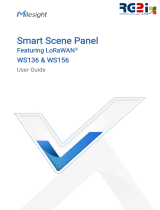
Contents
1. Product Introduction......................................................................................................................... 5
1.1 Overview ...................................................................................................................................5
1.2 Key Features ............................................................................................................................ 5
2. Hardware Introduction ...................................................................................................................... 5
2.1 Packing List ..............................................................................................................................5
2.2 Hardware Overview ................................................................................................................. 6
2.3 Buttons and LED Indicators .................................................................................................... 6
2.4 Dimensions (mm) .................................................................................................................... 6
3. Access the Sensor .............................................................................................................................7
3.1 Access without Plugin .............................................................................................................7
3.2 Access with Plugin .................................................................................................................. 8
4. Operation Guide ...............................................................................................................................10
4.1 Live Video ...............................................................................................................................10
4.2 IoT-People Counting ..............................................................................................................11
4.2.1 Region People Counting .............................................................................................11
4.2.2 Line Crossing Counting .............................................................................................. 12
4.2.3 People Flow Analysis ................................................................................................. 14
4.2.4 Recognition Scheme .................................................................................................. 15
4.2.5 Privacy Mask ...............................................................................................................15
4.3 IoT-Communication ...............................................................................................................16
4.3.1 LoRaWAN .................................................................................................................... 16
4.3.2 Milesight D2D ..............................................................................................................18
4.3.3 Wi-Fi ............................................................................................................................. 19
4.4 System ................................................................................................................................... 21
5. Mount the Sensor ............................................................................................................................ 24
5.1 Recommended Height for Certain Object ............................................................................24
5.2 Illuminance Requirements for AI Analysis ...........................................................................25
5.3 Recommended Installation for Line Crossing Counting .....................................................25
5.4 Factors Affecting Accuracy .................................................................................................. 26
5.5 Ceiling Installation .................................................................................................................27
6. Device Payload ................................................................................................................................ 27
6.1 Uplink Data .............................................................................................................................27
6.2 Downlink Command .............................................................................................................. 30
























